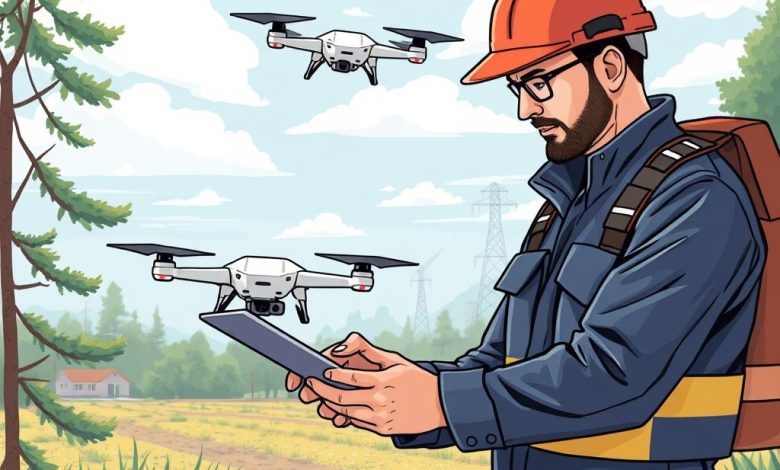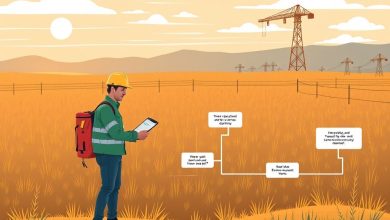Field Service Management with Drone-Based Remote Inspections Revolutionizing Asset Inspection and Maintenance

Introduction
Field Service Management (FSM) is a critical component of modern business operations, particularly in industries such as construction, utilities, and manufacturing. Traditionally, FSM relied heavily on manual inspections and human observation to assess equipment condition, infrastructure integrity, and project progress. However, with advancements in technology, drone-based remote inspections have emerged as a game-changing solution for FSM. This article explores the concept of Field Service Management with Drone-Based Remote Inspections, its benefits, implementation strategies, challenges, and future outlook.
- Evolution of Field Service Management
- Introduction to Drone-Based Remote Inspections
- Benefits of Drone-Based Remote Inspections in Field Service Management
- Improved Efficiency
- Enhanced Safety
- Cost Reduction
- Real-Time Data Collection and Analysis
- Environmental Impact
- Implementation Strategies for Drone-Based Remote Inspections in Field Service Management
- Infrastructure Setup
- Training and Certification
- Integration with Existing Systems
- Regulatory Compliance
- Challenges in Implementing Drone-Based Remote Inspections
- Initial Investment Costs
- Data Privacy Concerns
- Technical Limitations
- Battery Life and Weather Conditions
- Future Outlook for Drone-Based Remote Inspections in Field Service Management
- Advancements in AI and Machine Learning
- 5G Networks
- Increased Adoption Across Industries
- Standardization Efforts
- Conclusion
Evolution of Field Service Management
Field Service Management has undergone significant transformations since its inception. From paper-based scheduling systems to sophisticated software solutions, FSM has evolved to meet the demands of increasingly complex and interconnected businesses. The traditional approach to FSM involved:
- Manual data collection through physical site visits
- Paper-based reporting and communication
- Limited real-time visibility into field operations
- Reliance on human memory for assessment and decision-making
These limitations often led to inefficiencies, delays, and potential safety hazards. The advent of digital technologies, including cloud computing, mobile devices, and artificial intelligence, has revolutionized the way field services are managed.
Introduction to Drone-Based Remote Inspections
Drone-based remote inspections represent a paradigm shift in the field service management landscape. These unmanned aerial vehicles (UAVs), equipped with high-resolution cameras and sensors, allow for non-intrusive, real-time monitoring of assets and sites from above. This technology enables:
- Enhanced visual inspection capabilities
- Increased safety for personnel
- Reduced costs associated with travel and equipment maintenance
- Improved accuracy and consistency in data collection
Drone-based inspections can be applied across various industries, including:
- Construction: Monitoring building progress, detecting structural issues, and assessing roofing conditions
- Utilities: Inspecting power lines, pipelines, and other infrastructure
- Manufacturing: Overseeing production processes and quality control
- Agriculture: Crop health analysis and yield estimation
Benefits of Drone-Based Remote Inspections in Field Service Management
The integration of drone-based remote inspections into Field Service Management offers numerous advantages:
Improved Efficiency
Drone-based inspections significantly reduce the time required for site assessments. By eliminating the need for extensive ground coverage, technicians can quickly survey large areas, reducing overall inspection time by up to 70%. This efficiency gain allows for more frequent inspections, enabling proactive maintenance and issue resolution.
Enhanced Safety
One of the primary benefits of drone-based inspections is improved safety for personnel. By conducting inspections remotely, workers are protected from hazardous environments, such as confined spaces, high altitudes, or areas with toxic substances. This reduction in risk exposure leads to lower worker compensation claims and fewer workplace accidents.
Cost Reduction
Implementing drone-based inspections can lead to substantial cost savings:
- Reduced travel expenses: Eliminating the need for repeated site visits saves on fuel, vehicle maintenance, and accommodation costs.
- Extended asset lifespan: Early detection of issues through regular inspections prevents costly repairs and replacements.
- Optimized resource allocation: Data from drone inspections helps prioritize maintenance activities, ensuring resources are allocated efficiently.
Real-Time Data Collection and Analysis
Drone-based inspections provide instant access to high-quality visual data. This allows for immediate analysis and decision-making:
- On-site technicians can receive real-time feedback during inspections.
- AI-powered image recognition tools can automatically detect anomalies and flag potential issues.
- Historical data comparison becomes easier, facilitating trend analysis and predictive maintenance.
Environmental Impact
By reducing the number of physical site visits, drone-based inspections contribute to a smaller carbon footprint. This aligns with growing corporate social responsibility initiatives and sustainability goals.
Implementation Strategies for Drone-Based Remote Inspections in Field Service Management
Successfully integrating drone-based remote inspections into an existing FSM system requires careful planning and execution:
Infrastructure Setup
- Establish a robust Wi-Fi network capable of supporting real-time video streaming from drones.
- Implement a secure cloud storage solution for storing and managing inspection data.
- Set up a dedicated server for processing and analyzing drone-captured images and sensor data.
Training and Certification
Develop comprehensive training programs for technicians and inspectors:
- Educate staff on drone operation and safety protocols.
- Provide certification courses for drone pilots and data analysts.
- Offer ongoing training to keep employees updated with the latest technology and best practices.
Integration with Existing Systems
Ensure seamless integration between drone-based inspection systems and current FSM platforms:
- Develop APIs to facilitate data exchange between different software components.
- Implement standardized data formats for easy interpretation and analysis.
- Create custom dashboards for displaying inspection results alongside other FSM metrics.
Regulatory Compliance
Adhere to local and national regulations regarding drone usage:
- Obtain necessary permits and licenses for commercial drone operations.
- Ensure compliance with privacy laws when capturing footage over private properties.
- Regularly update knowledge on evolving regulations to maintain legal standing.
Challenges in Implementing Drone-Based Remote Inspections
While drone-based remote inspections offer numerous benefits, several challenges must be addressed:
Initial Investment Costs
The initial investment in drone technology, training, and infrastructure can be substantial. Companies must weigh these costs against long-term savings and efficiency gains.
Data Privacy Concerns
Ensuring the privacy of individuals and properties captured during inspections is crucial. Implementing robust data protection measures and obtaining necessary permissions may be required.
Technical Limitations
Drone-based inspections may not always provide the level of detail needed for complex assessments. In such cases, human inspection might still be necessary.
Battery Life and Weather Conditions
Drone operations are limited by battery life and weather conditions. This may require careful planning of inspection schedules and backup strategies.
Future Outlook for Drone-Based Remote Inspections in Field Service Management
The integration of drone-based remote inspections into Field Service Management is expected to continue growing:
Advancements in AI and Machine Learning
Improved AI capabilities will enable more accurate automated analysis of drone-captured data, reducing human intervention and increasing efficiency.
5G Networks
The rollout of 5G networks will provide faster data transmission speeds, enabling real-time high-resolution video streaming from drones without latency issues.
Increased Adoption Across Industries
As costs decrease and benefits become more apparent, drone-based inspections are likely to spread across various industries beyond construction and utilities.
Standardization Efforts
Industry-wide standards for drone operation, data collection, and analysis will emerge, facilitating easier integration and comparison of results across different companies and projects.
Conclusion
Field Service Management with Drone-Based Remote Inspections represents a significant leap forward in operational efficiency, safety, and cost-effectiveness. By leveraging this technology, field service managers can optimize their workflows, enhance decision-making processes, and contribute to sustainable business practices. As the industry continues to evolve, it’s crucial for FSM professionals to stay informed about emerging technologies and best practices in order to remain competitive in an increasingly digital landscape.




